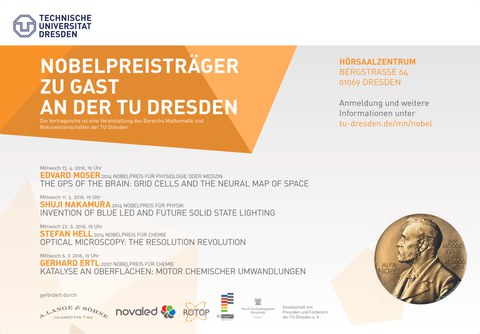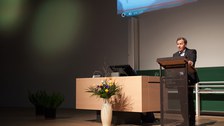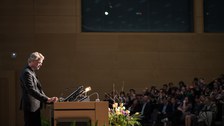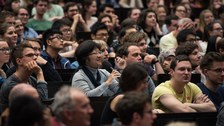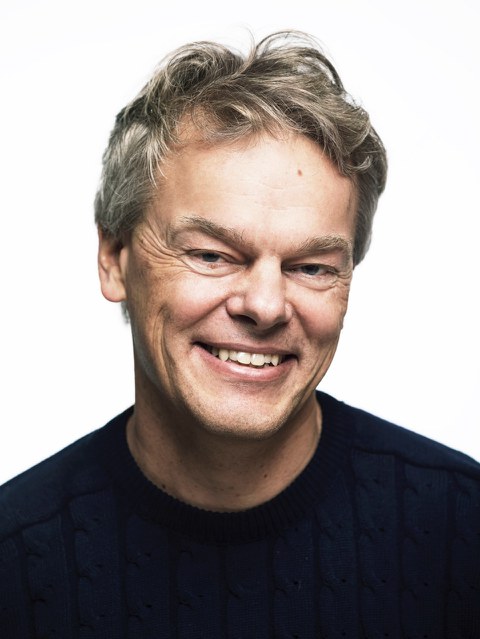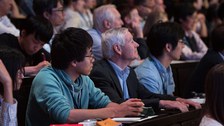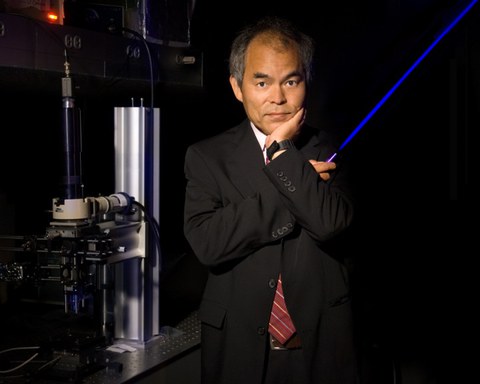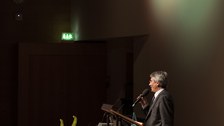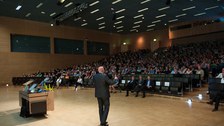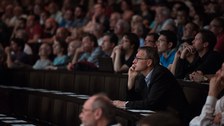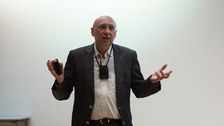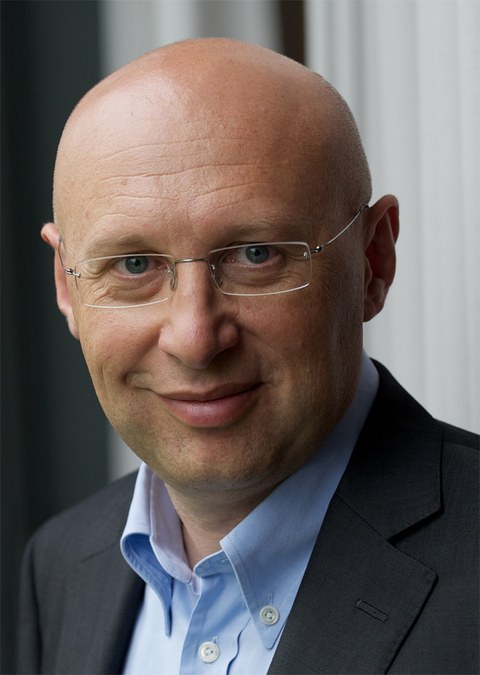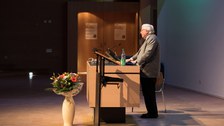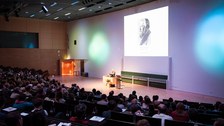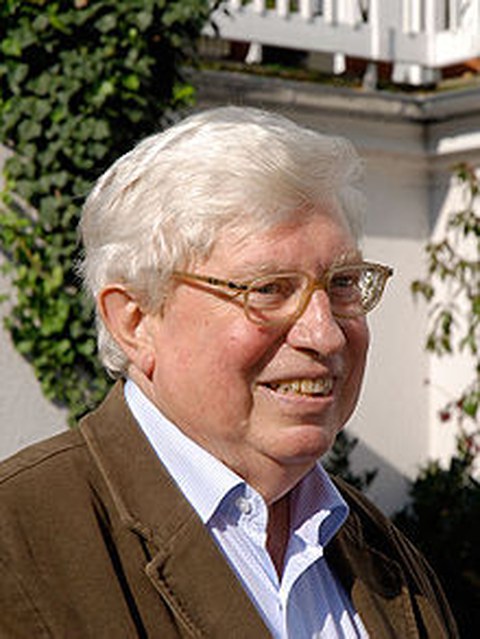Nobel Laureates at TU Dresden 2016
In 2016, the School of Science launched the public lecture series Nobel laureates at TU Dresden. More than 4.000 people attended the four events, all of which you can find images and impressions at the bottom of this page.
For the generous support of the lecture series 2016, the School of Science explicitly would like to thank: A. Lange & Söhne, Biotype Diagnostic GmbH, Novaled, Rotop, Gesellschaft von Freunden und Förderern der TU Dresden e.V., Hotel Taschenbergpalais Kempinski, Bülow Palais Dresden und Die Gläserne Manufaktur.
Wednesday, 13.04.2016, 7 p.m.
Edvard Moser - 2014 Nobel Prize in Physiology or Medicine
The GPS of the brain: Grid cells and the neural map of space

© Robert Lohse
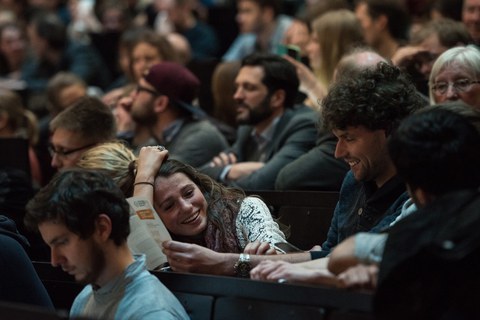
© Robert Lohse

© Robert Lohse

© Robert Lohse

© Robert Lohse

© Robert Lohse

© Robert Lohse

© Robert Lohse

© Robert Lohse

© Robert Lohse

© Robert Lohse

© Robert Lohse

© Robert Lohse

© Robert Lohse
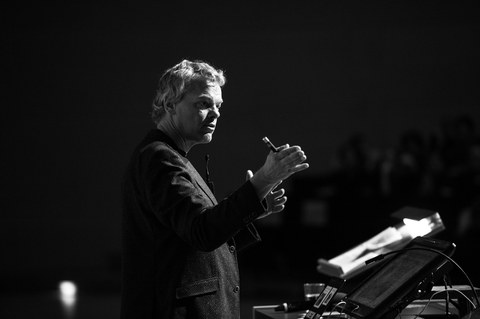
© Robert Lohse

© Robert Lohse

© Robert Lohse

© Robert Lohse

© Robert Lohse
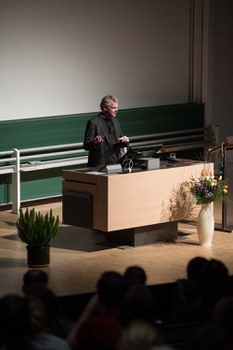
© Robert Lohse

© Robert Lohse

© Robert Lohse
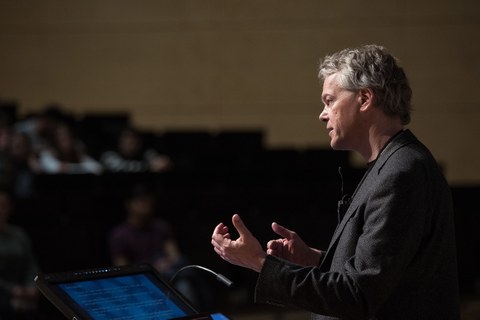
© Robert Lohse

© Robert Lohse

© Robert Lohse

© Robert Lohse

© Robert Lohse

© Robert Lohse
Edvard Moser (*27.04.1962, Ålesund, Norway)
The Norwegian neuroscientist Edvard Moser was awarded the Nobel Prize in Physiology or Medicine 2014 together with his wife May-Britt Moser and the British-American neurologist John O’Keefe for the research of the brain’s positioning system. Edvard Moser and his wife worked as visiting scientists at University College in London in the laboratory of John O’Keefe’s, who had been working on the functions of the human positioning system since the 70s. In 1996, Edvard and May-Britt Moser started working at the University Trondheim (Norway), where he now leads the Institute for Systems Neuroscience. Their joint work culminated in the discovery of so-called grid cells, which, in joint action with other cells, form the “GPS system” in our brain.
For more information: http://www.nobelprize.org/nobel_prizes/medicine/laureates/2014/edvard-moser-bio.html
Wednesday 11.05.2016, 7 p.m.
Shuji Nakamura – 2014 Nobel Prize in Physics
Invention of blue LED and future solid state lighting

© Robert Lohse

© Robert Lohse

© Robert Lohse

© Robert Lohse

© Robert Lohse

© Robert Lohse

© Robert Lohse

© Robert Lohse

© Robert Lohse
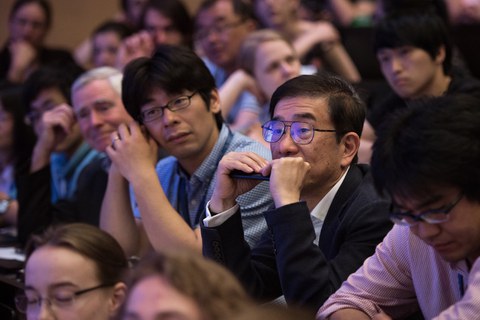
© Robert Lohse

© Robert Lohse

© Robert Lohse

© Robert Lohse

© Robert Lohse

© Robert Lohse

© Robert Lohse

© Robert Lohse

© Robert Lohse

© Robert Lohse

© Robert Lohse

© Robert Lohse

© Robert Lohse

© Robert Lohse
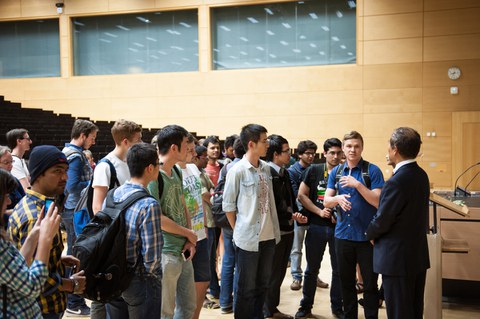
© Robert Lohse
Shuji Nakamura (*22.05.1954, Ikata, Japan)
The Japanese-born American material scientist Shuji Nakamura was awarded the Nobel Prize in Physics 2014 together with the Japanese researchers Isamu Akasaki and Hiroshi Amano for the development of blue light-emitting diodes (LEDs). Whereas red and green LEDs had been developed in the 1950s and 60s, the production of blue LEDs proved to be very challenging. It was not until 1992 that Nakamura, Akasaki and Amano achieved a breakthrough with the use of the semiconductor gallium nitride. The development of blue LEDs was the prerequisite for the production of white light using the combination of red, green and blue LEDs and thus, the basis for efficient, energy-saving light sources used world-wide.
Nakamura left Japan in 1999 and holds a professorship at the University of California, Santa Barbara, USA since 2000. He owns more than 200 American and over 300 Japanese patents.
For more information: http://www.nobelprize.org/nobel_prizes/physics/laureates/2014/nakamura-bio.html
Wednesday 22.06.2016,7 p.m.
Stefan Hell – 2014 Nobel Prize in Chemistry
Optical microscopy: the resolution revolution

© Robert Lohse

© Robert Lohse

© Robert Lohse

© Robert Lohse

© Robert Lohse

© Robert Lohse

© Robert Lohse

© Robert Lohse

© Robert Lohse

© Robert Lohse

© Robert Lohse

© Robert Lohse

© Robert Lohse

© Robert Lohse

© Robert Lohse
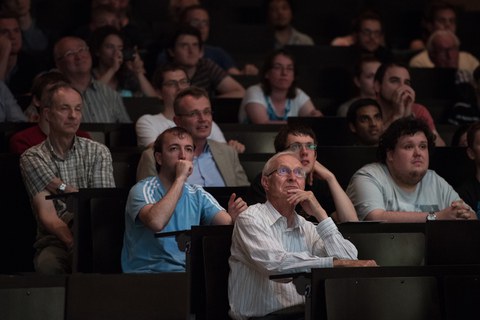
© Robert Lohse

© Robert Lohse

© Robert Lohse
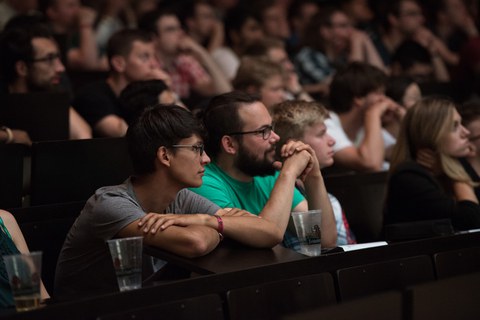
© Robert Lohse

© Robert Lohse

© Robert Lohse

© Robert Lohse

© Robert Lohse
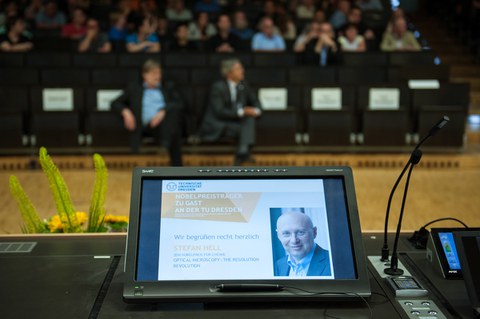
© Robert Lohse

© Robert Lohse

© Robert Lohse

© Robert Lohse

© Robert Lohse

© Robert Lohse
Stefan Hell (*23.12.1962, Arad, Romania)
Stefan Hell is the director of the Max Planck Institute for Biophysical Chemistry in Göttingen and head of the Division of Optical Nanoscopy at the German Cancer Research Center (DKFZ) in Heidelberg. He was awarded the Nobel Prize in Chemistry 2014 "for the development of super-resolved fluorescence microscopy". He shares the prize with his American colleagues Eric Betzig and William E. Moerner. The German physicist Hell has succeeded in exceeding the limitations of optical microscopy and thus, in laying foundations for optical nanoscopy. He developed the so-called “Stimulated Emission Depletion” (STED-) microscopy, which uses fluorescence to make nanoscale biological structures visible by chemical processes.
For more information: http://www.nobelprize.org/nobel_prizes/chemistry/laureates/2014/hell-bio.html
Wednesday 06.07.2016, 7 p.m.
Gerhard Ertl – 2007 Nobel Prize in Chemistry
Katalyse an Oberflächen: Motor chemischer Umwandlungen

© Robert Lohse

© Robert Lohse

© Robert Lohse

© Robert Lohse

© Robert Lohse

© Robert Lohse

© Robert Lohse

© Robert Lohse

© Robert Lohse

© Robert Lohse

© Robert Lohse

© Robert Lohse
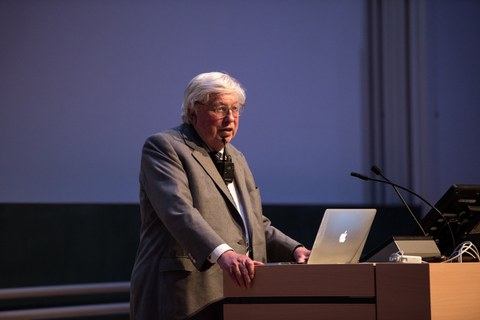
© Robert Lohse

© Robert Lohse

© Robert Lohse
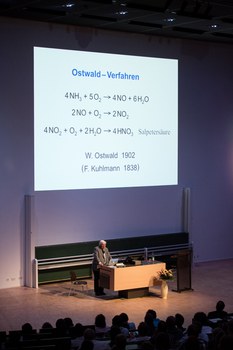
© Robert Lohse

© Robert Lohse
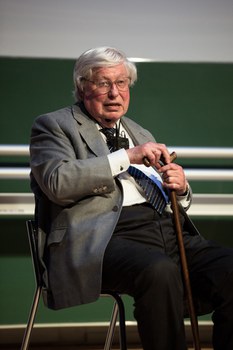
© Robert Lohse

© Robert Lohse

© Robert Lohse

© Robert Lohse
Gerhard Ertl (*10.10.1936, Stuttgart, Germany)
The German physicist and chemist Gerhard Ertl was awarded the Nobel Prize in Chemistry 2007 “for his studies of chemical processes on solid surfaces”. With his work, Gerhard Ertl, the Emeritus director of the Fritz Haber Institute of the Max Planck Society in Berlin, created the basis for the understanding of industrial catalysts and catalytic processes. His research findings are still widely employed, such as in the production of chemical fertilizers, efficient catalytic converters or in the investigations of climate phenomena.
For more information: http://www.nobelprize.org/nobel_prizes/chemistry/laureates/2007/ertl-bio.html

